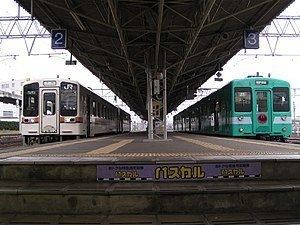Native name 紀勢本線 Stations 96 | Type Heavy rail Line length 384.2 km (238.7 mi) | |
 | ||
Operator(s) JR Central, JR West, JR Freight Terminis Kameyama Station, Wakayamashi Station | ||
The Kisei Main Line (紀勢本線, Kisei-honsen) is a railway line that parallels the coastline of the Kii Peninsula in Japan between Mie Prefecture and Wakayama Prefecture. The name takes the kanji characters from the names of the old provinces of Kii (紀伊) and Ise (伊勢).
Contents
- Jr 223
- Basic data
- Services
- JR Central
- JR West
- Passenger
- Freight
- History
- Double tracking
- Electrification
- Other notable dates
- Former connecting lines
- References
The line is operated by Central Japan Railway Company (JR Central) from Kameyama, the eastern terminus, to Shingū, and by West Japan Railway Company (JR West) from Shingū to Wakayamashi, the western terminus. The segment between Shingū and Wakayama is nicknamed as the Kinokuni Line (きのくに線), after the alternate name of the Kii Province.
The line has connections with through service, to the Kansai Main Line for Nagoya via Ise Railway, and to the Hanwa Line at Wakayama terminus for Osaka.
Jr 223
Basic data
Services
The (Wide View) Nanki limited express runs between Nagoya and Kii-Katsuura with four return workings a day via the Ise Railway. The Kuroshio runs between Kyoto/Shin-Osaka/Tennōji and Shingū with 16 return workings a day.
The line is generally divided to five parts for local services, by Shingū, Kii-Tanabe, Gobō, and Wakayama.
JR Central
JR West
Passenger
Freight
History
The line is composed of sections opened by four different railway companies, which were then nationalised and linked by the JGR/JNR.
In 1891, the Kansai Railway opened the Kameyama to Tsu section, with the Sangu Railway opening the Tsu to Shoka section in 1893. At the western end, the Kiwa Railway opened the Wakayamashi to Wakayama section in 1903, and was acquired by the Kansai Railway the following year. The Kansai Railway and the Sangu Railway were nationalised in 1907. In 1912, the Shingu Railway opened the Kii-Katsuura to Miwasaki section, extending the line to Shingu the following year. The company was nationalised in 1934. On the eastern side of the Kii Peninsula, the Japanese Government Railway (JGR) extended the line from Shoka to Owase in sections between 1923 and 1934, whilst on the western side, it extended the line from Wakayama to Esumi in sections between 1924 and 1938. In 1935, the Kii-Katsuura to Taiji section was opened by JGR, extended to Kushimoto the following year, and to Esumi in 1940, providing a link to Wakayama and Osaka. The successor to JGR, the Japanese National Railways (JNR), opened the Owase to Shingu section in stages between 1956 and 1959, completing the line.
Double-tracking
The Akogi to Takajaya section was double-tracked in 1909, with the Matsusaka to Tokuwa section double-tracked two years later. In 1944, both sections were returned to single track and the recovered materials recycled for the Japanese war effort. The Wakayama to Kii-Tanabe section was double-tracked in stages between 1964 and 1978.
Electrification
The line was electrified between Wakayama and Shingu in 1978, with the Wakayama to Wakayamashi section being commissioned in 1984.
Other notable dates
CTC signalling was commissioned between Wakayama and Shingu in 1978, and extended to Kameyama in 1983.
Freight services ceased in 1986.
